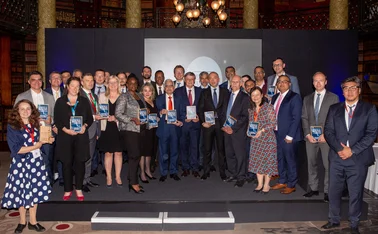
Risk manager: Central Bank of Brazil
G20 central bank has made important breakthroughs in applying ERM

Creating harmony between front-office investment professionals and middle-office risk managers is not always trivial. Often, they can work as though they have different objectives. A trader may spot what she believes is a terrific new tactical investment opportunity for the year ahead, but may be constrained from taking such a position because the trade would not fully match risk compliance rules. Yet it is equally possible that the transaction itself could fit in with the central bank’s overall strategic objectives if they were better understood, set out and embedded.
The Central Bank of Brazil (BCB) has spent a number of years redesigning its approach to risk management, which was first embraced in foreign reserves in 1997, as reserve levels started to rise and new market risk metrics, such as value-at-risk, were developed to assess market risk factors across currencies, interest rates, emerging markets, time deposits, fixed income and so on. Now, instead of looking at risk at the end of an investment decision process, risk considerations are increasingly being embedded at the start and all the way along the process – resulting in risk management being closely aligned to the central bank’s strategic goals.
To do this, the Brazilian central bank first sets out the strategic objectives for the institution. It then deploys an enterprise-wide approach to risk management (ERM) – including specific focus on strategic, reputational and operational risks, in addition to market, liquidity and credit risks. It subsequently ties this in with the management of foreign exchange reserves or other areas. The objective is to ensure that all risks are considered at the time that investment managers review potential new market positions – so that risk is fully reflected as part of the investment decision, rather than as a function of compliance.

Strategic objectives are defined by the board, and usually have a long time horizon. In the early 2000s, the strategy for reserves was defined by three main goals: currency hedging of Brazilian liabilities; the role of gold as a financial asset; and a conservative risk tolerance. The accumulation of forex reserves since then (Brazil held around $350 billion at the end of 2019) resulted in new strategic objectives, such as asset class diversification, countercyclicality, investments in new currencies and the choice of the numeraire for portfolio optimisation, among others. “Therefore, the strategic asset allocation approach became a complex, multi-objective, risk-focused exercise, relying on a robust methodology,” says Isabela Maia, head of the corporate risk and benchmark department at the Central Bank of Brazil.
Meanwhile, the international reserves management framework was based on a three-pillar approach: operational references (strategic benchmark); guidelines (limits for deviation from the benchmark); and performance evaluation. The success of this approach was in turn incorporated into the ERM framework, and, as a consequence, reserves investment procedures are now integral to the risk management process led by the Brazilian central bank’s governance, risk and control committee (GRC).
Improved transparency
Maia says the “alignment of reserves investment to overall BCB strategies” has allowed the “increase of transparency for stakeholders”: “Annually, a corporate risk report with an aggregated view of the Central Bank of Brazil’s risks is presented to the GRC. The international reserves management also has two dedicated and detailed periodic reports: a quarterly report on reserves management and risks that is presented to the GRC members; and an annual report that is released to the public on the central bank’s website.”
The strategic asset allocation approach became a complex, multi-objective, risk-focused exercise, relying on a robust methodology
Isabela Maia, Central Bank of Brazil
Maia says the annual forex reserves report is much more detailed than the “usual information provided by central banks on their foreign reserve investments”. She adds that it is very important that stakeholders have a deeper understanding of the risks and returns of reserve investments.
During the strategic asset allocation process, interaction with the board is crucial to properly understand the risk preferences, which goes well beyond the financial risks. Strategic, reputational and operational risk perceptions, among others, should also be reflected in the strategic benchmark. Likewise, it is fundamental to provide the best risk information available, both qualitative and quantitative, to the decision-makers. This holistic approach facilitates the achievement of a portfolio better aligned to the central bank’s strategic objective and investment preferences. It also helps to segregate strategic decisions from market views or tactical decisions.
Framework implementation
The implementation of the framework was possible because of the development of a high level of risk management skills that go well beyond traditional risk management models and systems – although these were also needed. The design of the decision-making process required managerial skills and support from the board, and collaborative work took time to evolve to the current level of maturity.
In particular, the Central Bank of Brazil continues to place a significant effort in updating its risk models, which are organised in three distinct categories: confirmation reduced-form models (parametric models that analyse and describe a complex phenomenon in terms of its simple or fundamental constituents), which attempt to explain behaviour; perception models, which try to capture the perceptions of specialists in an organised and scientific framework; and recognition models, which aim to identify patterns using a big data analysis without any preconceived world view.
Recognising that relevant information cannot be captured using parametric models, the Brazilian central bank is starting to model the “perceptions” of market participants by assigning probabilities to more intangible human views that certain events may transpire, says Maia. It is also unleashing artificial intelligence to extract patterns from data. The development work on ‘perception’ and ‘AI models’ is ongoing, with more results expected this year. But the effort should further align investment and risk. As Maia says: “We are trying to develop financial risk models that add information to the reductionist models, aiming to improve the risk data quality that we provide to the decision-making process.”
The Central Banking Awards were written by Christopher Jeffery, Daniel Hinge, Dan Hardie, Rachael King, Victor Mendez-Barreira, Alice Shen and William Towning
Only users who have a paid subscription or are part of a corporate subscription are able to print or copy content.
To access these options, along with all other subscription benefits, please contact info@centralbanking.com or view our subscription options here: http://subscriptions.centralbanking.com/subscribe
You are currently unable to print this content. Please contact info@centralbanking.com to find out more.
You are currently unable to copy this content. Please contact info@centralbanking.com to find out more.
Copyright Infopro Digital Limited. All rights reserved.
You may share this content using our article tools. Printing this content is for the sole use of the Authorised User (named subscriber), as outlined in our terms and conditions - https://www.infopro-insight.com/terms-conditions/insight-subscriptions/
If you would like to purchase additional rights please email info@centralbanking.com
Copyright Infopro Digital Limited. All rights reserved.
You may share this content using our article tools. Copying this content is for the sole use of the Authorised User (named subscriber), as outlined in our terms and conditions - https://www.infopro-insight.com/terms-conditions/insight-subscriptions/
If you would like to purchase additional rights please email info@centralbanking.com






